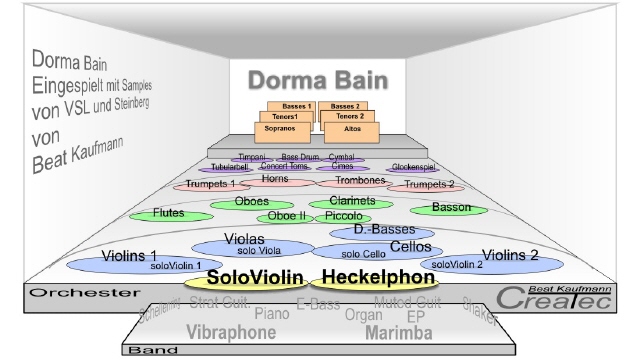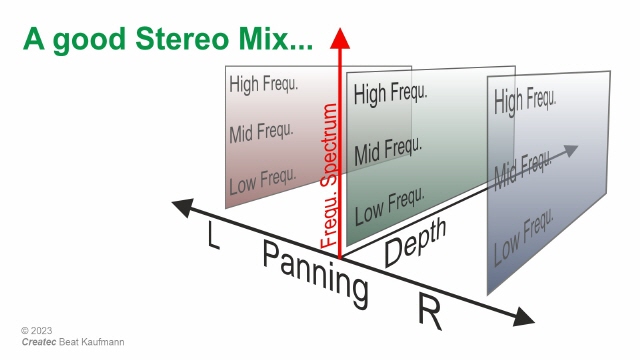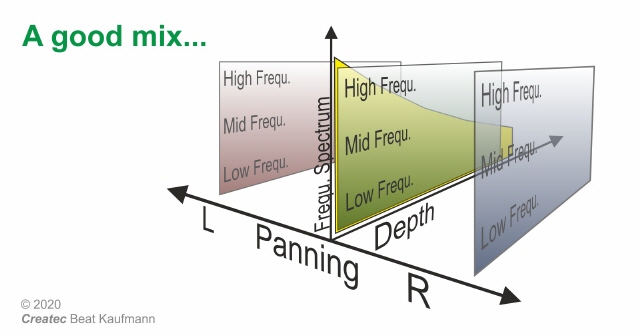Mixing (VSL) Samples
Using dry samples for producing music needs to mix them.
1. For getting a transparent sound.
2. For creating a sound which the listeners are used to
You will find some ideas, tips and proposals here. Have fun.
- Examples
- What is a good mix?
- How to do?
- Listen once more...
- Reverb-Concept
- Compare with originals

The difference between mixed samples and unmixed is enormous.
Listen for yourself:
A) No mix - just the sum of all instruments (Dorma Bain)
B) Mixed and mastered (Dorma Bain)
The mix is much more transparent, it has a certain ease and you hear the individual instruments much better ...
... if you do it right...
What makes up a good orchestra mix?
It sounds transparent.
It has an "open" sound with some "air".
It has got a natural ambiance (Concert Hall, Church,...).
It has got a natural dynamic (also within the instrument sections).
It has a well balanced frequency response over all.
It follows the physics of acoustic laws.
It applies the 3 dimensions (see under "How to do?")
All just important instruments (melody/melodies) are well audible.
All non-important instruments (no melody) are not well audible individually.
etc.
----------
It contains not too much reverb.
It contains no dominating frequencies.
It sounds not "muddy" within the bassrange and over all.
It is not "overdriven".
It is not too much compressed or limited (without any dynamic).
All non-important instruments (no melody) are not well audible individually.
etc.
A good mix - explained graphically
Use all the three dimensions:

1. Panning
The instruments are positioned from left to right. Sometimes there are specifications, for example when you want to keep a classical seating position of an orchestra. With good monitors, you can detect a lot of different positions. On poor systems, it is sometimes difficult to identify only 5 positions.
(Left - Left centre - Centre - Right centre - Right)
Headphones are not very suitable for this task because the sound from the left channel is completely missing at the right ear. However, our hearing can only locate sounds perfectly if both ears can perceive the sound in question.

Good monitor systems can resolve many more positions. This is especially the case when the sound of all the different drivers of a studio monitor is emitted in the correct time.

Frequency spectrum
At each position, if possible, make sure that only one instrument occupies a frequency range. Otherwise, there is a danger of masking instruments that play a little quieter. If you want to reproduce the classical seating arrangement in a mix, then there is a danger that the 2nd violins will be masked by the 1st violins, which play (louder) in front of them. The same can happen to wind instruments (e.g. woodwinds) which are positioned behind the violins on the left side. It is therefore advisable to think carefully about whether you want to take the classical seating method in a mix, or whether you would rather choose a "mix-friendly" positioning.

Mix-wise, a better arrangement of orchestral instruments (beware of narrowing instruments at the back from a panning point of view).
With this seating arrangement, there are fewer masking effects than with the classical orchestra setup.

Room depth
This mix dimension is often quite underestimated, although it can often provide a massive increase in transparency in a mix. Listen from the sound sample from 0:45 to about 1:50. Pay attention to what spatial depth can do in a mix. I don't mean mainly the reverb tail but actually the depth of space in which the instruments are positioned.
(Music: Simeliberg, Swiss Traditional, arr. B. Kaufmann)
Mix without Room Depth
Mix WITH Room Depth
Attention: However, the "Mixdimension Depth" only really works if the accompanying physical acoustic laws are taken into account.
1. The further away instruments are, the darker they should sound.
2. the further away instruments are, the more they move into the centre of the sound body "orchestra".

1. Use the Panner of your DAW-mixer-channels
I drawed my virtual stage and panned the instruments from left to the right within their corresponding depths. The Band got its own mix as we are used to. It was not placed within the Concerrt Hall
2. Create depths for several instrument sections
As you can see on the stage I used 5 different depths within this peace. If you take the band and the soloists as well we have got 7 depths. OK it seems to be a bit too much. Nevertheless, to have the solo violin in front of the string quartett is very nice.

3. Assign correct frequencies so that different sections have their own frequency range.
First mention: Listen for example to the strings: The solo violin got a shiny (1:25)sound, the string quartet (1:08) sounds a bit darker and the orchestra strings got a warm and even darker sound (1:35). That's what I mean with "the farther the darker".
Even if the orchestra strings don't sound very bright they are always audible because they got their own place in the depth.
Second mention: I placed the Glockenspiel and the violins 2 on the right so that they will never be covered by all the other high instruments on the left. At the mean time we have a nicer stereo sound this way.
Third mention: I arranged the the piece so, that I most time had no problems to distribut the frequency ranges to the all the playing sections.
Last mention: Such mixes are more interesting for listeners than those automatic mixes done by MIR and Co.
I wish you successful mixes!
Beat Kaufmann
This could be a Reverb-Concept for reaching good results:
The following video example nicely shows how this reverb concept can be implemented:
All instruments are placed in their corresponding room depth...
Compare with originals
It is extremely important to keep comparing your results with original recordings, because our ears get used to "weird" sounds incredibly quickly. So it can happen that you spend a whole night with a mix. Sometimes you tweak there, then somewhere else. In the end, you think you've found THE ORCHESTRAL SOUND.
If you were to compare it with an original recording of an orchestra, you would realise that you have moved quite far away from the "right sound".
Example 1: Reference <> VSL-Mix
In the example above, however, the discolouration is caused by VSLs MIR. The MIR-wet component is probably too high for the many instruments (>30%), so that the overall colouration of the selected room (IRs) is too strong. The wet component would probably have to be reduced to around < 25% in each case for getting less acoustic coloration.
Example 2:
ET-Theme (Reference - a real orchestra)
My version with samples from VSL:
ET-Theme (My piece, made with samples of VSL)
You can hear that it is interpreted and mixed a bit differently (less distance/reverb), but there is no real discolouration like in the first example above...
So the mix seems to be OK, at least as far as the sound is concerned...
Important
To compare, the two examples must first be made equally loud!
© Copyright, Createc Beat Kaufmann, 2004 - 2025

